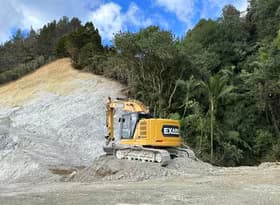
A financial health check for the construction industry
Our latest forecasts predict an 8.0% decline in construction investment activity over the year to September 2024. Falls in activity are forecast to be broad-based, with a 14% decline in non-residential investment, a 7.7% drop in residential work, and a 2.6% dip in infrastructure activity. The decline comes as part of a longer-term moderation in construction work, with annual activity predicted to fall 12% between June 2021 and March 2026, taking activity to its lowest level since early 2018. Although the decline in activity has been modest to date, are we seeing any signs of stress in the construction industry?
Measured profits still look good
Business financial data from Stats NZ up to the September 2023 quarter suggests that businesses in the construction industry remain in good health in aggregate. Construction was understandably affected by Covid lockdowns in 2020 and 2021 more heavily than the overall economy, with little or no ability for staff in the industry to work from home. But since the Omicron outbreak in the first half of 2022 (which coincided with major supply chain issues for the industry), operating profits in the construction industry have been healthy. Chart 1 shows that total operating profits in the industry over the last year have averaged 42% above their pre-Covid 2019 level, compared to 20% above for the broader economy.
We concede that some, or most, of this growth in profits is inflation-related, with Stats NZ’s capital goods price indices for construction rising between 25% (civil construction) and 37% (residential buildings) since 2019. Nevertheless, the key is that profits appear to be healthy and are still rising compared with a year ago – as are other financial indicators including sales, operating expenditure, and salaries and wages. The financial data does not indicate an industry in contraction at a headline level.
But survey responses are downbeat
However, data from the NZIER’s Quarterly Survey of Business Opinion provides a different picture of profitability. Net responses to questions about profitability experienced over the last three months and expected over the next three months have both been deeply negative during 2023 (see Chart 2). In the most recent survey for December 2023, a net 56% of firms in the building industry stated their profitability had deteriorated over the last three months, well below the long-term average of 19% of firms recording worse profitability. The previous quarter’s result, at -61%, was the most negative response since 1998.
Expected profitability over the next three months improved in the December quarter to a net -16% response, the best result in over two years, and a sharp contrast to the previous quarter’s 14-year low. These figures show a similar trend to responses from the construction sector to ANZ’s Business Outlook survey. Both surveys suggest that conditions in the construction industry might not be as rosy as Stats NZ’s financial data indicates.
Part of that divergence might be due to the nature of these various measures. Stats NZ’s operating profits data is the combined total of all construction firms’ financial situations – and so larger organisations make up a big part of the finances for the sector. The QSBO is unweighted, meaning that construction firms large and small are treated equally in the survey. This difference might also explain why smaller operators, anecdotally, appear to be more pressured.
More bad debts and liquidations
Responses from the Quarterly Survey of Business Opinion about overdue debtors also provide insight into the financial health of the construction industry. A net 38% of respondents experienced an increase in overdue debtors (ie the firm was waiting for someone to pay them) over the last three months, which was the second highest response since 2008/09 and the Global Financial Crisis (see Chart 3). A net 42% of respondents expect overdue debtors to increase next quarter – a reduction from the previous quarter’s 49%, but still well above the long-term average of 9%.
Data from Centrix (see p11) shows that company liquidations in the construction industry held at between 50 and 80 per quarter in 2021 and the first half of 2022. Liquidation numbers rose to over 100 in the September 2022 quarter and have held in the 100-130 per quarter range since then. Centrix has identified that construction companies are currently 2.2 times more likely to fail than the typical NZ business. Non-residential building construction firms are presently the most likely to be liquidated, despite non-residential work put in place reaching a record high in mid-2023 (see Chart 4). However, the struggles in the construction industry are widespread, and only firms involved in the repair of residential buildings currently have a liquidation rate lower than the economy-wide average.
The missing piece of the puzzle is how the current liquidation numbers compare to the downturn in the wake of the Global Financial Crisis. Construction liquidation numbers might have doubled since 2021, but we suspect they are still probably low compared to 2008-2011. However, without the data, we just don’t know.
Things are likely to worsen during 2024
Although residential consent numbers have retreated 27% from their peak in May 2022, this decline has not yet been reflected in activity levels, with residential work put in place in the year to September 2023 down by just 3.3% from its high at the end of 2022. Non-residential activity is also on the way down from its 2023 peak. We are already seeing signs of stress in the construction industry, although for the data we have, the figures do not look as bad as in 2008/09. We expect 2024 to be tough for the industry, and financial indicators are likely to worsen throughout the year. Businesses would be well-advised to be cautious about who they extend credit to in coming quarters.






















